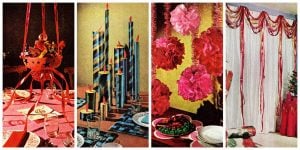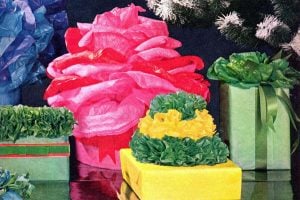Baby Gen X loved these Puppet Storybooks with 3D lenticular pictures on the covers
The artists used puppets to illustrate the stories — a technique that closely resembled the Japanese stop-motion animation look that was so popular at the time, such as those seen in Rankin/Bass productions like “Rudolph the Red-Nosed Reindeer.”

One thing that was extra fascinating to boys and girls was the 3D image that was mounted on the front of each book cover. Those bright and colorful pictures changed when they were tilted because they featured lenticular printing, which gave each one the illusion of depth and motion.
I know there was at least one little girl who, in the early 70s, tried not only to figure out how the image worked… but wanted to find a way to step into the picture of that house Santa was visiting. 🤩
While Puppet Storybooks are now out of print, you can often find vintage editions on eBay — see what’s currently available here.

Puppet Storybooks (1968)
Here are tried-and-true tales for very young children — all selected for simple text and ability to provide reading and listening pleasure, and made even more attractive by beautiful color illustrations of adorable puppets in lifelike poses that are an endless delight.

3-D Puppet Storybooks (1969)
These familiar rhymes and fairy tales have delighted generations of children. Now, with their new 3-D covers and full-color puppet-like illustrations, they’re more irresistible than ever!
Each book has strong laminated pages with rounded corners that make them safe for little ones to handle. They’re bound to keep any youngster happily absorbed for hours on end. $1.25 each.

Fairytales and rhymes in Puppet Storybooks (1970)
The world’s best-loved rhymes and fairy tales come almost literally to life in the pages of these books; colorful puppets act out the story on every page in beautiful full-color illustrations.
What is lenticular printing?
Lenticular printing creates the illusion of depth or motion on a flat surface by using a special lens, often a plastic sheet with grooved ridges, to display different slices of an image. As you view the picture from various angles, the appears to change or move, creating a dynamic visual effect.

This kind of low-tech 3D printing dates back to the early-to-mid 20th century. Over the years, it was on more than just book covers, but was popular for creating novelty items like postcards and trading cards, as well as appeared on prizes inside many vintage cereal boxes and old Cracker Jack boxes.

Lenticular printing still holds a nostalgic charm (especially to Baby Boomers and members of Generation X), but it’s actually seen a resurgence in popularity over the last two decades, particularly with advancements in technology that have made it more accessible and cost-effective.

Modern manufacturing techniques can create higher-quality lenticular prints with more nuanced changes in the images, as compared to the simpler, often less refined versions that were common in the past. Digital printing has made it easier to produce these types of prints on a larger scale, making them more common in mainstream media and advertising.
It is commonly used in various forms of advertising, packaging, and promotional materials to capture attention through its unique visual effects — and the eye-catching images are still a popular feature on modern-day bookmarks like these.
A Puppet Storybook: Snow White (1969)

Henny Penny: A Puppet Storybook (1969)
by T Izawa & S Hijikata – Published by Grosset & Dunlap, Inc.

The Three Little Kittens: A Puppet Storybook (1969)

Fun With the Alphabet: A Puppet Storybook (1969)
Pictures by T Izawa – Published by Grosset & Dunlap, Inc.

Cinderella: A Puppet Storybook (1971)

Vintage books for kids: Hansel and Gretel (1970)

The Night Before Christmas: A Puppet Storybook (1970)
This cute retro kids’ book featured a retelling of the classic Christmas poem, “A Visit from St. Nicholas,” by Clement Clarke Moore.

It traces the very simple day of a child who lives in a stereotypically nuclear family: A dad who works all day, and a mom who stays home and takes care of the kids — a boy and a girl.
So, yes, the story itself is not exactly exciting — but the magic comes from the vintage puppets and sets that have been created with a stop-motion animation look.
Retro-style kids’ book: What Time Is It? (1969)
A Puppet Storybook from 1968, with 3D lenticular printing on the cover
Pictures by T Izawa / Published by Grossett & Dunlap – New York


7am: What time is it? It’s wake-up time!
Bobby is still sleepy. But the sun is already up, its bright face peeking over the treetops to the east. It’s seven o’clock in the morning.

10am: After breakfast
After breakfast, Bobby’s mother starts to clean house. Bobby goes outdoors to play. He rides in his wagon and swings high in a swing. Soon it is ten o’clock.

Noon: 12pm
Noontime! That’s another name for twelve o’clock. Bobby’s mother prepares a delicious lunch. Bobby is hungry. He eats everything and drinks his milk. Mmm-m! Yummy!

2:30pm: Naptime
The big hand on the clock in Bobby’s room points to the six — and that means it’s half past some hour.
The smaller hand has moved past the number two. It’s really between the numbers two and three. What time is it? It’s half past two. Time for a nice nap.

4pm: Playtime
Bobby finds his coloring book. He looks for a good picture to color. Then he picks out some crayons and goes to work. It’s now four o’clock in the afternoon.

6:30pm: Evening
What time is it now? It must be the time when Daddy comes home. Yes, there’s Daddy! The two hands on the clock are almost together, near the six. It’s half past six.

8pm: Bedtime
After his supper, Bobby brushes his teeth and gets ready for bed. It is eight o’clock. There may be time for a story. Then Bobby will say good night and go to sleep.

Title list: Puppet Storybooks – all books available as of 1969
0751 SNOW WHITE AND THE SEVEN DWARFS
0752 THE THREE LITTLE KITTENS
0753 JACK AND THE BEANSTALK
0754 THE LITTLE RED HEN
0755 HERE WE GO ROUND THE MULBERRY BUSH
0756 COUNTING RHYME
0757 MOTHER GOOSE
0758 PETER RABBIT
0759 HENNY PENNY
0760 FUN WITH THE ALPHABET
0761 WHAT TIME IS IT?
0762 THE HOUSE THAT JACK BUILT
0763 BABY ANIMALS
0764 HAPPY BIRTHDAY
0765 LITTLE NURSERY RHYMES
0766 A CHILD’S GARDEN OF VERSES
0767 THE NIGHT BEFORE CHRISTMAS
0768 THE THREE LITTLE PIGS
0769 PINOCCHIO
0770 BEDTIME STORIES
GROSSET & DUNLAP, INC. New York, N. Y. 10010




















5 Responses
I forgot all about these books. Talk about bringing back memories!
I loved these books as a young girl. I would scratch the cover and get lost in the magic of the stories. The pages were so colorful and animated I would get lost for hours. Thank you for this article. I’m on a quest to try and collect them all.
I love the happy birthday book. I remember reading this one over and over.
I had the Hansel and Gretel as well as the Pinocchio lenticular books. Wow…so long ago.
I have one of these from my childhood. It was always my favorite. I loved the cover and the unique puppet photos that told the story. Mine is Rumpelstiltskin, but I don’t see it listed here. I would love to collect some of these vintage books.